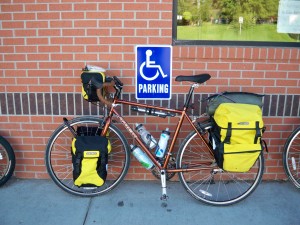Are you considering a self-supported, long-distance bicycle trip sometime in the future? Choosing a touring bicycle that will get you there comfortably and safely requires some forethought. Here are some features to look for as you prepare your own shopping list.
Comfort features
1. Size. Like road bikes, touring bicycles are sized to the specific dimensions of the rider. You will be virtually living on this bicycle for weeks, so make sure you have a bicycle that fits you. Bicycle shops can provide advice, and even diagnostic tests, to set you up on a bicycle tailored to your unique body design.
2. Seat. No easy answer here. Be prepared to discard the seat that comes with your bicycle. If you already own a comfortable seat, test it with long rides on your new bicycle. But don’t expect the same level of comfort when you start logging 75 miles day-in and day-out. Many swear by leather saddles, but they have long break-in periods. You’ll likely need to try several seats before finding the right one.
3. Frame. Today’s frame materials are designed with performance in mind, but many provide for a very stiff ride. Good, old-fashioned steel will be more forgiving with the bumps, more durable over the long haul, and sturdy enough for the heavier load.
4. Drop bars. Handlebars with drops will allow for more hand positions while riding. Allow for this flexibility to help minimize the numbness and tingling of hands and wrists from miles of pressure-packed leaning and tension.
5. Stem. Some may even opt to install a stem that provides for a more upright body position.
Touring features
1. Bottle cages. Can your bicycle mount at least three water bottle cages? You will need this amount of fluid capacity and more for those long, hot days in the sun.
2. Wheel base. Touring bicycles have a longer wheel base. One reason is to allow space for the cyclist’s heels to clear the rear panniers when pedaling. Don’t get caught in a bind between the gear you are carrying and the miles you are cranking.
3. Braze-ons. Make sure there are enough appropriately placed mounts to affix the racks you choose.
Mechanical features
1. Bar-end shifters accommodate easy adjustments to the gears by novice mechanics when located miles away from bicycle shops.
2. Running gear. You will indeed be miles away from services on a regular basis. Invest in high-quality, time-tested running gear. Has the gear you are considering proven itself on the open road?
Durability features
1. Tires. Invest in puncture resistant, hard case tires for a comfortable, safe, and worry-free ride. Opt for smoother treads to reduce rolling resistance, assuming your tour will be predominantly on paved surfaces.
2. Wheels. Choose wheels with the higher spoke counts (e.g. 36) and double-walled rims. How many people are really qualified to be replacing and adjusting spokes? Although you should be prepared for a repair job like this, do you really want to be replacing spokes when you could be exploring or burning up more miles?
3. Racks. Even self-supported tourists who pack light will be carrying substantial weight on their bicycles. Choose sturdy racks that can withstand the weight and provide a sway-free ride. Then apply some lock-tite to prevent the rack’s screws from loosening.
The wise selection of the right touring bicycle can insure that time spent on the tour is worth the money invested. Pay up for the right equipment and enjoy the ride!

